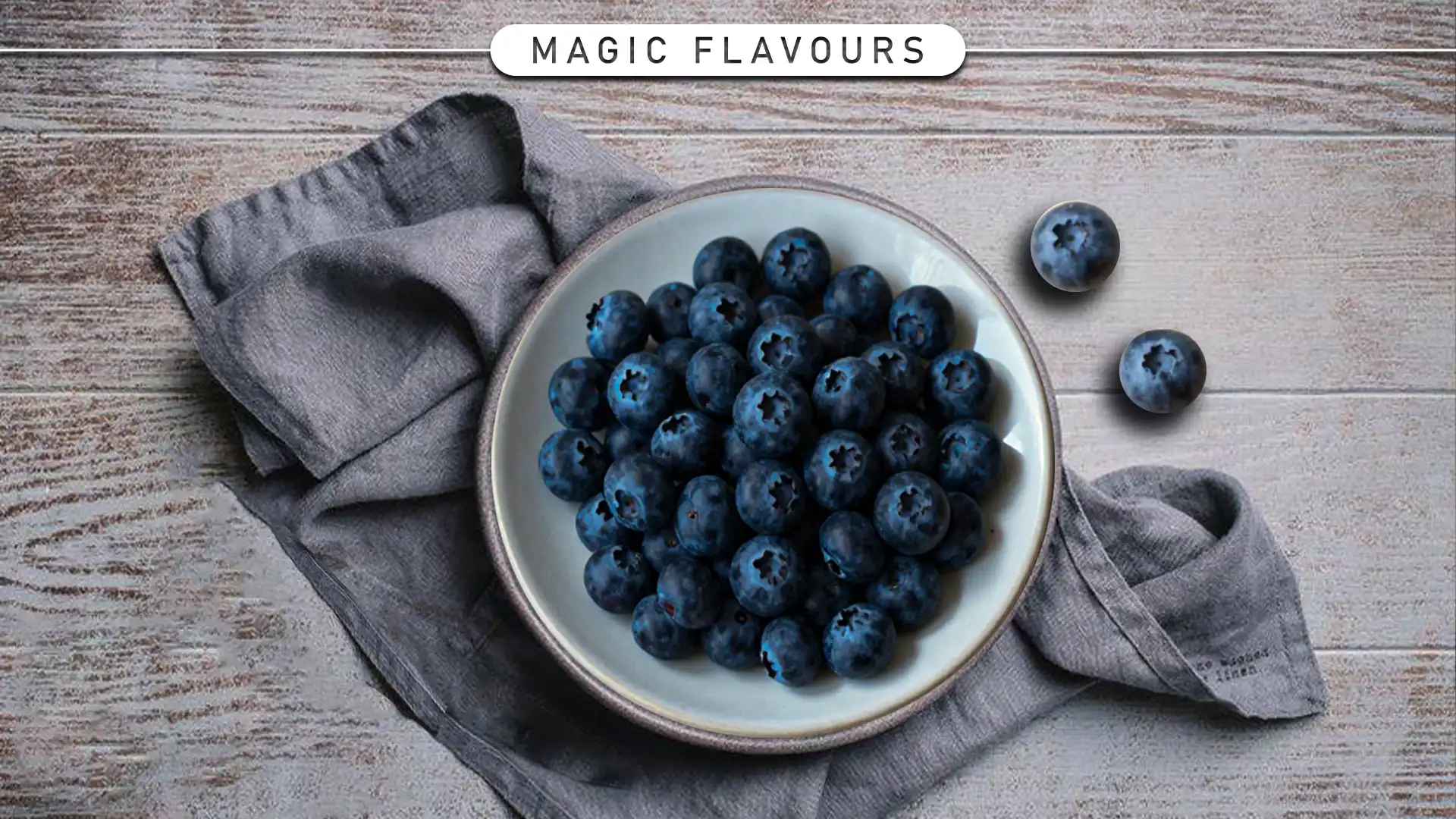Introduction
Blueberry flavor has become one of the most beloved and versatile fruit notes in the global flavor market. It brings a naturally sweet, tangy, and refreshing sensation that appeals across cultures and categories. As consumers increasingly seek authenticity and health-conscious choices, the demand for natural flavor continues to grow worldwide.
Moreover, brands are turning to this flavor to create products that feel both nostalgic and modern. Whether in beverages, confectionery, or tobacco, blueberry flavor delivers a sense of freshness and familiarity. At the same time, its balance between sweetness and acidity allows it to adapt easily to different formulations.
In today’s market, the rise of clean-label trends and transparent sourcing highlights the importance of using natural ingredients. Consequently, natural flavor not only meets regulatory expectations but also connects emotionally with consumers seeking real, nature-inspired experiences.

What Is Natural Blueberry Flavor?
Definition and Composition of Blueberry Flavor
Natural blueberry flavor refers to a flavoring substance derived directly from real blueberries or other natural sources. It contains volatile compounds that reproduce the fruit’s characteristic sweet-tart profile. These compounds include esters, aldehydes, and ketones, which work together to deliver the recognizable blueberry flavor aroma and taste.
Additionally, this flavor captures both the juicy freshness and mild earthiness of ripe berries. Through natural extraction and concentration, manufacturers can preserve the fruit’s authentic sensory notes. As a result, natural blueberry flavor achieves a balance that feels genuine rather than artificial.
Moreover, each component of the flavor contributes to a realistic and consistent product experience. Because of its chemical complexity, blueberry flavor blends easily with other fruity, creamy, or herbal notes. Therefore, it serves as a flexible ingredient for developing innovative and appealing formulations.
Sources and Extraction Methods
Natural blueberry flavor originates primarily from blueberry fruit, juice, or puree. However, it can also include natural compounds derived from other plants that mimic blueberry notes. This approach allows manufacturers to create authentic profiles while maintaining cost efficiency.
Extraction techniques such as steam distillation, solvent extraction, and cold pressing are commonly used. Each method helps capture volatile aromatic compounds without damaging their delicate structure. Furthermore, advanced technologies now enable cleaner, more sustainable extractions that enhance purity and flavor retention.
Consequently, natural flavor maintains its vibrant color, aroma, and taste across multiple applications. By combining modern extraction science with traditional fruit processing, producers achieve high-quality, stable flavor ingredients. Therefore, this process ensures both consistency and natural authenticity in every finished product.
Applications of Blueberry Flavor Across Industries
Blueberry Flavor in Foods and Beverages
Blueberry flavor is one of the most popular fruity notes in foods and beverages. It adds sweetness, freshness, and a touch of tartness that appeals to a wide range of consumers. In bakery items, it enhances muffins, pastries, and pancakes with a fruity and comforting aroma. Likewise, in dairy and desserts, it enriches yogurts, ice creams, and cheesecakes with vibrant berry notes.
Furthermore, in beverages, this flavor gives juices, smoothies, and energy drinks a natural and refreshing character. Its balanced sweetness pairs perfectly with citrus, apple, and mint-based profiles. As a result, it creates multi-layered taste experiences that consumers associate with health and indulgence.
Because of its natural appeal, this flavor fits well within clean-label and better-for-you product trends. Consequently, brands use it to deliver authentic taste while supporting wellness-focused marketing strategies.
Blueberry Flavor in Cosmetics and Personal Care

Blueberry flavor has also found its place in cosmetics and personal care products. It adds a fruity and pleasant aroma that evokes freshness and vitality. Lip balms, glosses, and creams often include blueberry notes to enhance sensory pleasure and brand appeal.
In addition, blueberry’s natural association with antioxidants strengthens its market image. Consumers perceive blueberry-scented products as rejuvenating and nourishing. Therefore, manufacturers often highlight this flavor alongside botanical or vitamin-rich ingredients to reinforce health and beauty benefits.
Moreover, the gentle and uplifting scent profile makes blueberry ideal for daily-use products. It blends smoothly with vanilla, floral, or citrus tones for balanced formulations. Consequently, this flavor continues to gain popularity in skincare, body care, and fragrance categories.
Blueberry Flavor in Tobacco and E-Liquids

Blueberry flavor is increasingly used in tobacco and e-liquid formulations. Its sweet, smooth, and mildly tangy character complements a variety of base notes. In hookah and shisha tobacco, blueberry adds freshness and natural fruit depth to the smoke experience.
Additionally, it blends well with mint, grape, or cream-based flavors, creating layered and harmonious profiles. These combinations appeal to users seeking balance between sweetness and coolness. Therefore, this flavor has become a key ingredient in premium and fruit-forward tobacco blends.
E-liquid producers also rely on its consistency and stability for reliable vapor performance. Because of its clean aroma and crowd-pleasing sweetness, it enhances user satisfaction. Consequently, this flavor remains a preferred choice in modern flavor development for tobacco and vape applications.
Market Trends and Consumer Demand for Blueberry Flavor
Rising Demand for Natural and Clean-Label Blueberry Flavor
The global market shows a clear shift toward natural and clean-label blueberry flavor. Consumers increasingly prefer flavors derived from real fruit or natural sources. This trend is driven by growing awareness of health, transparency, and authenticity. As a result, manufacturers focus on natural extracts and sustainable production methods.
Moreover, natural flavor aligns with wellness-oriented lifestyles. It supports “no artificial additives” positioning while maintaining vibrant, authentic taste. Consequently, food and beverage brands use it to meet consumer expectations and enhance trust.
In addition, innovation in extraction technology allows better preservation of blueberry’s aromatic complexity. These advances enable brands to deliver more realistic and stable flavor experiences. Overall, the shift toward natural flavor strengthens its role in premium and health-conscious product categories.
Flavor Innovation and Customization in Blueberry-Based Products
Blueberry flavor innovation continues to evolve across industries. Brands now focus on customized flavor profiles that suit specific applications. For instance, lighter, fresher notes fit beverages, while deeper, jam-like tones enhance confectionery or tobacco products.
Furthermore, advances in flavor technology allow precise control of sweetness, acidity, and aroma intensity. As a result, manufacturers can tailor this flavor to match local taste preferences. This flexibility encourages creativity and regional adaptation in product development.
Additionally, this flavor blends beautifully with other fruits, spices, and botanicals. When paired with mint, vanilla, or citrus, it creates new multisensory experiences. Consequently, innovation in blueberry flavor drives brand differentiation and consumer engagement.
Growing Popularity of Blueberry Flavor in Emerging Markets
Blueberry flavor is rapidly gaining traction in emerging markets worldwide. Consumers in Asia, the Middle East, and Latin America increasingly seek fruity, refreshing, and bold profiles. Because blueberry represents modernity and health, it appeals strongly to younger demographics.
Moreover, its versatility allows easy adaptation into local products such as juices, candies, and shisha flavors. As a result, it bridges traditional and contemporary preferences effectively. In regions where berry flavors are still novel, blueberry creates opportunities for category expansion.
Additionally, as disposable income rises, consumers in emerging economies flavor premium experiences. Blueberry flavor’s association with quality and wellness aligns with this demand. Consequently, it continues to grow as a global favorite in both mainstream and niche product categories.
Production and Extraction Methods of Natural Blueberry Flavor
Natural Extraction from Blueberries
Natural blueberry flavor is obtained through advanced extraction processes that preserve its authentic aroma and taste. Typically, producers use solvent extraction, steam distillation, or cold pressing methods. Each technique captures volatile compounds that define the fruity, tangy, and sweet profile of blueberries.
Moreover, the extraction process aims to retain delicate notes that make this flavor unique. Controlled temperature and pressure ensure flavor compounds remain stable and pure.
As a result, the final extract delivers a true-to-fruit experience ideal for food, beverage, and tobacco products.
In addition, natural extraction supports clean-label claims and consumer trust. Because the flavor is derived directly from real blueberries, it meets demand for transparency and authenticity. Overall, natural extraction is the foundation of premium blueberry flavor used across industries.
Use of Biotechnological and Enzymatic Methods
Recent advances in biotechnology have transformed blueberry flavor production. Manufacturers now use microorganisms and enzymes to generate natural aroma compounds. This biotechnological approach offers sustainable and efficient alternatives to traditional extraction.
Furthermore, enzymatic reactions help enhance or replicate specific notes found in blueberries. By adjusting conditions, producers can amplify sweetness, freshness, or juiciness. Consequently, the resulting blueberry flavor becomes more stable and consistent across batches.
In addition, biotechnological production reduces waste and energy consumption. It supports eco-friendly practices while maintaining the natural status of the flavor. Overall, biotechnology enables the creation of authentic, high-quality flavor that satisfies both environmental and sensory expectations.
Quality Control and Flavor Consistency
Maintaining quality and consistency in blueberry flavor production is essential. Manufacturers use analytical tools such as gas chromatography and mass spectrometry to monitor compound profiles. These tests ensure every batch meets defined sensory and safety standards.
Moreover, consistency is critical for global brands that rely on uniform taste experiences. Advanced blending and calibration techniques guarantee stable performance in different product formulations. As a result, consumers enjoy reliable flavor whether in beverages, desserts, or tobacco.
Additionally, strict hygiene and sourcing standards protect flavor integrity. Only high-quality raw blueberries or natural precursors are used. Overall, quality control ensures natural flavor remains authentic, stable, and trusted across all applications.
Health, Safety, and Regulatory Considerations for Blueberry Flavor
Safety and Allergen Considerations
Blueberry flavor is generally recognized as safe for use in foods, beverages, and personal care products. Regulatory authorities monitor its composition and usage limits. Moreover, natural extracts are tested for contaminants to ensure consumer safety.
Additionally, allergy considerations are minimal but must be assessed for concentrated or blended forms. Proper labeling ensures transparency for sensitive consumers. As a result, brands maintain trust while offering enjoyable blueberry-flavored products.
Overall, adherence to safety standards guarantees that this flavor remains both safe and appealing across applications.
Regulatory Compliance Across Industries
Regulatory frameworks differ by region and industry for this flavor. Food authorities require clear labeling of natural or artificial sources. Moreover, cosmetic and personal care regulations govern concentration limits and ingredient disclosure.
In addition, manufacturers must comply with local guidelines to market products legally. For example, health claims about antioxidants or wellness benefits require substantiation. Consequently, regulatory compliance ensures consumer protection and brand integrity.
Furthermore, consistent documentation supports traceability and quality assurance. Therefore, adherence to regulations is critical for global product distribution of blueberry flavor.
Storage and Stability Guidelines
Proper storage preserves the quality and sensory integrity of this flavor. Exposure to heat, light, or oxygen can degrade its aroma and taste. Therefore, it should be stored in airtight, opaque containers under cool conditions.
Moreover, following stability guidelines ensures consistent performance in beverages, confectionery, and personal care products. Regular quality checks confirm potency and freshness across batches. As a result, brands can guarantee the same authentic blueberry experience to consumers.
Overall, correct storage and handling practices maximize flavor longevity and maintain regulatory compliance.
Future Outlook and Opportunities for Blueberry Flavor
Growing Consumer Demand for Natural Flavors
Consumer interest in natural and authentic flavors continues to rise. Blueberry flavor, with its clean and fruity profile, meets this growing demand. Moreover, consumers increasingly associate it with freshness, wellness, and indulgence.
In addition, brands are incorporating this flavor into more products, from beverages to snacks. This trend supports both clean-label and premium positioning. Consequently, blueberry flavor is expected to see continued adoption across multiple industries.
Overall, the demand for natural, recognizable flavors positions this flavor as a key ingredient for future innovation.
Innovation in Product Development
Blueberry flavor opens opportunities for creative product development. Companies can combine it with other fruits, spices, or botanical flavors. Moreover, it allows brands to explore unique beverage blends, desserts, and functional foods.
Additionally, technological advances such as flavor encapsulation enable stability in diverse applications. This allows precise control over aroma, sweetness, and intensity. As a result, this flavor can be consistently delivered across global products.
Furthermore, innovation supports differentiation in crowded markets. Therefore, this flavor remains central to both sensory enjoyment and product storytelling.
Emerging Markets and Regional Opportunities
Emerging markets present significant growth opportunities for blueberry flavor. Regions with growing middle-class populations are showing rising demand for natural, fruity flavors. Moreover, seasonal fruit-inspired trends enhance its appeal.
In addition, local preferences allow tailored formulations of this flavor. Some markets prefer sweeter profiles, while others favor tangy, tart nuances. Consequently, manufacturers can adapt products to regional tastes, increasing acceptance.
Overall, this flavor is poised for global expansion, offering both sensory appeal and commercial potential across industries.
Conclusion: The Enduring Appeal of Blueberry Flavor
Blueberry flavor remains a versatile and highly sought-after ingredient across multiple industries. Its fresh, fruity, and slightly tart profile enhances foods, beverages, confectionery, cosmetics, and even nutraceuticals. Moreover, its natural perception and health associations make it ideal for clean-label and wellness-oriented products.
Additionally, advances in extraction, formulation, and stabilization allow manufacturers to deliver consistent, high-quality blueberry flavor across diverse applications. It pairs seamlessly with other flavors, offering creative possibilities for product innovation and sensory experiences.
Finally, with rising consumer demand for natural, indulgent, and functional products, this flavor is poised for continued growth. Its adaptability, appeal, and premium positioning make it a cornerstone for brands aiming to captivate consumers worldwide.
